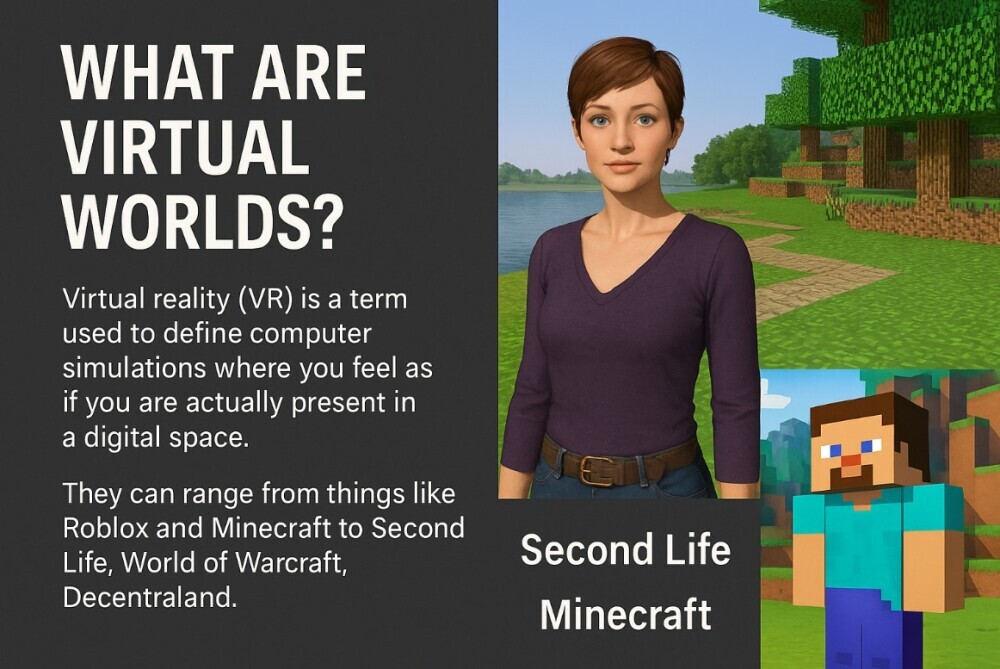Are you a fan of The Matrix films? Or maybe Lawnmower Man or Ready Player One? I love all of these films because they merge the real world we live in with imaginary virtual ones. AND they pose some very intriguing questions about the nature of reality while they’re at it.
Virtual worlds have grown in popularity and potential in recent years, not just in films but in the gaming industry, too. I was a huge fan of Second Life when it first came out, and I completely regret not thinking like an entrepreneur back then when it was all still new and wide open.
So maybe now is the perfect time for a beginner’s guide to virtual worlds and an introduction to how these exciting ‘realities’ could be a potential source of income for online entrepreneurs. At the very least, they’re a brilliant source of fun!
Why Virtual Worlds Matter in 2025
My adventure into these digital landscapes has revealed a realm full of opportunities. As 2025 unfolds, these environments offer beginners a chance to learn, create, and even earn money. Kids are making money on YouTube by showing off their Minecraft builds; others are creating Roblox tutorials or running custom games.
And when you move into the virtual worlds aimed at adults, you’ll find serious business investment and product placement all over cyberspace!
This beginner’s guide is designed to explain some key ideas and cover the basic equipment needed for anyone dipping their metaphorical toe into virtual worlds for the first time since Tron.

What are virtual worlds?
Virtual reality (VR) refers to computer-generated simulations where you feel as if you’re actually present in a digital space. These can range from kid-friendly platforms like Roblox and Minecraft to more expansive environments like Second Life, World of Warcraft, and Decentraland.
In fact, most video games take place in some form of virtual world. Players take on a character or avatar and use it to interact with the environment and others.
When I was growing up, I played Dungeons & Dragons, which was a kind of precursor to today’s virtual games. We’d spend hours inhabiting an imaginary world, battling dragons or whatever the Dungeon Master had in store for us. Virtual worlds are the digital evolution of that same idea – places to explore, create, and collaborate.
Virtual economies and real money
These days, virtual worlds go well beyond just gameplay. Many now include the option to buy and sell digital goods and services. And some of these virtual currencies can be exchanged for real money.
Of course, to play, you have to pay – whether that’s a few pounds for a new game or a serious investment in high-end gear. But don’t be put off. There are ways to ease into it without spending a fortune.
The basics
Your adventure into any virtual world will require a good computer or gaming system because most virtual environments are often demanding on computer performance. In most cases, you will need:
- A modern computer with a fast processor
- Sufficient memory (RAM)
- An advanced graphics card
- Fast and reliable internet connection (Fast broadband makes sure that data transfers quickly, reducing lag in online experiences)
- Headset with microphone
- Monitor (or dual monitors depending on your set up)
- A keyboard, mouse or game controller
- VR headset for some platforms but not all games/worlds
Alongside hardware, the software and platforms you choose matter. Many virtual worlds operate like games at the same time, including economic activities. You can update your avatar, the ‘skin’ it has, the clothes, weapons, or transportation… for a fee! Some platforms also let users buy and sell digital real estate or goods, and advertising in these worlds is now big business. An informed choice early on can save time and money in the long run.
Choosing the right platform and tools from the start can save you time and money later on. Trust me – there’s nothing more annoying than being dropped from a world because your system can’t keep up!

Getting started with virtual worlds
Stepping into a virtual world can be as exciting as it is puzzling. I found that the best way to start is to familiarise yourself with popular platforms. For many beginners, exploring environments like Open Virtual World or sandbox-style simulations can ease the learning curve. But what do I mean by these terms?
“Popular platforms” are environments like Second Life or Decentraland, where you can get comfortable navigating and interacting in virtual spaces.
“Open Virtual World” refers to platforms with open-ended or expansive digital spaces that are less restrictive, allowing for more freedom to explore and create. Examples include:
- Second Life: A well-established platform where you can create avatars, interact socially, and explore an expansive world. It’s beginner-friendly and offers a lot of creative freedom.
- Decentraland: A blockchain-based virtual world where you can purchase land, build experiences, and interact with others. It’s a popular option for beginners interested in the intersection of virtual worlds and cryptocurrency.
- VRChat: While more immersive with VR headsets, you can also use it on a regular screen to interact with others in creative and user-generated environments.
“Sandbox-style simulations” are virtual worlds where users have the flexibility to build, modify, and interact in the environment without rigid goals or rules. These types of simulations are great for learning as they encourage creativity and experimentation, making the transition into more complex virtual environments smoother. Examples here include:
- Minecraft: A highly popular sandbox game where you can build and explore vast blocky worlds. It’s accessible for all age groups and perfect for honing your creativity. Mostly aimed at kids.
- Roblox: A platform offering user-created games and experiences where you can explore and design your own virtual worlds. Mostly aimed at kids.
- The Sims (especially Sims 4): While focused on life simulation, its build mode allows for incredible creativity and experimentation.
I’m really advising you to start simple and gradually develop your understanding and confidence in navigating virtual worlds.

Initial things to do
The first step involves setting up an account on the platform of choice. Platforms often require a registration process that verifies your identity. While the idea of sharing details online may seem daunting, using secure sites can ensure your data is safe. Many platforms offer beginner tutorials and community support forums. It is usually a good idea to make use of these resources as they can help you navigate initial challenges.
Avatars
Once signed up, you can customise your avatar. The avatar represents your presence in the digital space. I liked creating avatars with the basic tools available on the platform to get a feel for the controls and features. However, I LOVED buying additional skins and powers to really make my avatar my own. On Second Life, other players can design and create these items for other people to buy, which is one way they can make money from playing in the virtual world. So, it is worth spending some time on customisation because it helps you become more comfortable with your avatar and with the platform. Remember in the new Jumanji, where the characters have different traits and abilities? Your avatar will start with the basic ones, and you can add things over time either through experience or by purchasing them.
Exploration
Exploring the environment is another important step. It helps to visit virtual shops or community hubs where you can meet other people and get to know what’s happening. This is often where exchanges occur, so these are great places to hand out, especially if your aim involves monetising your activities. Beyond that, ‘the world is your oyster,’ so go out and explore. There is usually a map which allows you to move quickly between different zones. You may need to gain different abilities in order to get from one place to another, like flying, swimming or driving a car.

Use the lingo – understand the jargon
Virtual worlds, like many niches in life, have their own jargon and you would do well to invest some time and effort to understand this as you start your journey. Here are a few useful terms:
- Avatar: Your digital persona.
- Digital real estate: Virtual land you can buy or rent.
- Microtransactions: Small payments made to unlock features or goods.
- NFT: Non-fungible tokens used to prove ownership of unique digital items.
Think Before You Spend
Before throwing money at a new game or piece of tech, consider:
- Costs: High-performance computers and VR headsets can be pricey.
- Learning curve: Some platforms are more complex than others.
- Security: Always protect your data. Use secure passwords and consider a preloaded debit card for purchases.
- Time investment: These worlds are absorbing – and it’s easy to lose hours if you’re not careful!
Community forums and YouTube tutorials are great for picking up tips and getting help.
To conclude… a word of warning!
Remember that virtual worlds are inhabited by real people pretending to be someone else and it is wise to remember that the same people that exist in the real world can exist in the virtual world too – with all their foibles, eccentricities and motivations! Cyberbullying can be a problem in virtual worlds too, so choose your friends carefully and seek support if you need it.
That said, immersing yourself in a completely different world is a fantastic way to relax and have fun! I love the excitement of becoming someone else – maybe that’s the drama teacher in me! However, be warned – you may well get drawn in and find yourself spending more time in your virtual world than the real world. So, when your teenage children are telling you to get off the computer and give them some dinner, you may have to rethink your strategy!!
Next time, we’ll talk more about the business opportunities in these worlds and how you can monetise your time in them.
Related articles
Monetising virtual real estate in the metaverse
Beginner’s guide to Blockchain, Smart Contracts and Etherium
Honest Review of Wealthy Affiliate 2025

This is almost like making a fairy tale come to life. I haven’t personally experienced virtual worlds, but your article has tempted me to try them out. If you go into this properly, though, it can become quite addictive and time-consuming, especially if you get hooked on building and buying new virtual spaces.
I wonder how long it will be before people can bring their virtual spaces into their own living spaces, for example creating a virtual view of another world by your window?
Hi Michel. Thanks for stopping by. Yes – it really is like stepping into a fairy tale sometimes – which is why I love it! I totally agree with you about the addictive side too… once you start customising or building your own space, the hours just vanish. And I love your idea about bringing virtual worlds into our homes – imagine having a view out your window that changes to a moonlit forest or a cyberpunk cityscape! At the rate things are developing, I honestly don’t think we’re far off. I know you can do this using a TV and art images so this kind of augmented reality might be the next leap forward. ????
This was such an eye-opener Gail and honestly a really fun read too. I’ve always been curious about virtual worlds but never fully dove in because I wasn’t sure where to start or what gear was actually needed. The way you broke everything down here makes it feel way more approachable.
I’ve played around with Roblox and Minecraft with my kids, but reading this got me thinking more about adult-focused platforms like Second Life or Decentraland. One thing I’ve been wondering though—how important is it to start with a VR headset, or can a regular desktop setup still give you a solid experience?
Also, when it comes to creating content or offering services inside these worlds, are there certain platforms that are better for monetizing than others? I’ve got a background in design and storytelling so the idea of building something inside a virtual space really appeals to me.
I think this kind of guide is exactly what beginners need right now. The space feels overwhelming at first, but you showed how it can actually be fun, creative, and maybe even profitable if you approach it the right way. Looking forward to reading more when you dive into the business side of it.
Shawn
Hi Shawn. Glad to see you back again and I hope you are keeping well. Thanks for reading the article and I’m glad it has fired you up to dive into the amazing virtual world environments. It’s certainly a fun way to pass the time! To answer your question, a VR headset is not necessary at all – only for some very specific games, but the majority you can fully engage with just through the screen. Obviously, the VR headset and platforms will give you the feeling of being in the game because of the surround picture and sound, whereas when you’re playing on a computer, you can see the rest of the room you’re sitting in. However, I’ve found that with a little imagination, you can be anywhere and be anyone! I like playing fantasy characters most but that’s just what I like. Real estate can be very expensive but you can start out creating some designs or clothes and start small. Let me know how you get on and which platform you dive into – even if it’s running around Roblox with your kids!